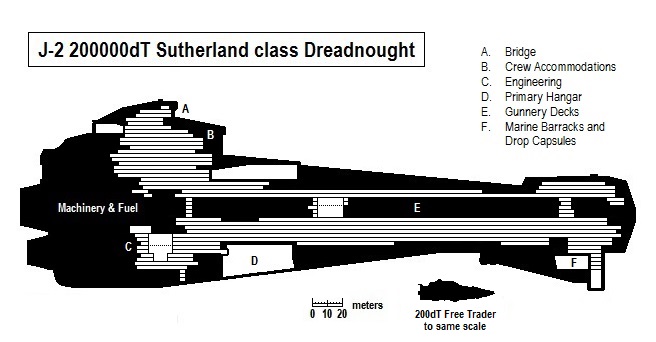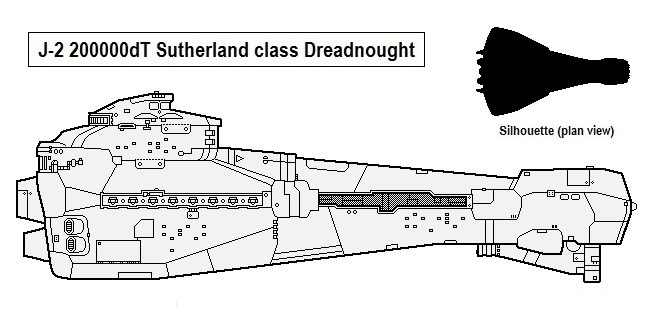Sutherland class Ship of the Line
| Sutherland class Ship of the Line | |
|---|---|
 Distant Fringe vessel. | |
| Type: BP Dreadnought | |
| Category | BCS |
| Size | 200,000 Tons |
| Hull Configuration | Wedge Hull |
| Streamlining | Streamlined Hull |
| Tech Level | TL–12 |
| Engineering | |
| Computer | Model/6 fib |
| Jump | J-2 |
| Maneuver | 5 G |
| Armaments | |
| Hardpoints | 2,000 |
| Accommodations | |
| Staterooms | 0 |
| Personnel | |
| Crew | 1,782 |
| Officers | 253 |
| Enlisted | 1,529 |
| Marines | 200 |
| High/Mid Passengers | 0 |
| Payload | |
| Cargo | 180 Tons |
| Fuel tank | 0 Tons |
| Construction | |
| Origin | Unity of Sed |
| Year Operational | Circa 1100. |
| End of Service | 1130 (projected) |
| Price | |
| Cost | MCr264,701.55 (base) MCr211,761.24 (qty) |
| Architect fee | MCrMCr2,647.016 |
| Statistics | |
| Quick Ship Profile | Not applicable |
| Images | |
| Blueprint | Yes. |
| Illustration | Yes |
| Source | |
| Also see | Dreadnought |
| Canon | Published, fan design |
| Era | 1105 (Golden Age) |
| Reference | Fan: Ronald B. Kline, Jr. |
| Starships are designed with the Classic Traveller format, using High Guard Shipyard v1.13 written by Andrea Vallance. | |
The Sutherland class Ship of the Line is a heavy warship.
- It is a military ship and a Dreadnought.
- The vessel is a TL-12 design.
- Please also see AAB article: Ships of the Distant Fringe.
- Please also see AAB article: Warships of the Distant Fringe.
Description (Specifications)
It is a heavy battle vessel with 5-G and J-2 performance. They are are in service with the Unity of Sed Navy. Like all vessels in the Distant Fringe their jump performance is limited by their DeVoss Drives.
- These vessels carry the maximum armor possible and mount a Type K spinal meson gun as their primary weapon system, backed by multiple particle accelerator and missile bays. Energy weapons serve in offensive or defensive roles as required. Defenses include repulsor bays, sandcaster turrets, and both meson screens and nuclear dampers.
- It ordinarily carries x10 10-dTon Arvan class Fighters, x10 30-dTon Caroline class Heavy Pinnaces, and x180 Assault Capsules.
- It has a 1,782 sophont crew and 200 marines.
Image Repository
General Description
The Sutherland class is a streamlined, flattened wedge with a mean width of 160 meters, a mean height of 95 meters, and a length of around 400 meters: a boxy dorsal superstructure adds an additional 40 meters of height. The superstructure, the squared bows and the irregular shape of the hull increases the overall internal space, giving the ship a total enclosed volume of approximately 2.7 million cubic meters.

A basic deck plan of the vessel indicating the general layout and positioning of major elements.
Basic Ship Characteristics
Following the Imperial Navy and IISS Universal Ship Profile and data, additional information is presented in the format shown here. The small craft factor indicates the number of squadrons (...of ten subcraft) carried on the ship. Tonnage on the universal ship profile is shown in kilotons (...thousands of tons) where necessary. [1]
| Basic Ship Characteristics [2] | ||
|---|---|---|
| #. | Category | Remarks |
| 1. | Tonnage / Hull | The Sutherland class is constructed using a 200,000 dTon hull built in a wedge configuration. The hull is streamlined and has good atmospheric capability: its atmospheric handling characteristics are entirely reliant on its onboard gravitic systems.
|
| 2. | Crew | Total Crew Complement: x1,782
Accommodations
Accessible areas of the hull are fitted with grav plates and inertial compensators and have full life support and environmental systems.
|
| 3. | Performance | The vessel mounts a DeVoss-type Jump-2 drive, a Maneuver-5 drive, and a Power Plant-6, giving performance of Jump-2, 5G acceleration, and producing 12,000 Energy Points. The ship has an agility rating of 3 and an emergency agility of 5. The internal fuel tankage is sufficient for one Jump-2 and gives the power plant 4 weeks duration.
|
| 4. | Electronics | Adjacent to the bridge is a Model/6 fib ship computer: there is a backup Model/6fib Computer.
|
| 5. | Hardpoints | 2,000 hardpoints.
|
| 6. | Armament | The normal weapons fit-out for a Sutherland class is:
x1 Type K spinal mount Meson Gun. x10 100-ton Bays mounting Particle Accelerators x40 100-ton Bays mounting heavy Missile launchers.
x420 dual Fusion Gun turrets, typically grouped into fourty-two batteries each of 10 linked turrets. x400 triple Beam Laser turrets, typically grouped into fourty batteries each of 10 linked turrets. |
| 7. | Defenses | The hull is heavily plated, braced and structurally reinforced, giving it an armor rating of 12.
x10 100-ton Bays mounting Repulsors. x500 triple Sandcaster turrets, typically grouped into fifty batteries each of 10 linked turrets. The vessel is equipped with a meson screen and a nuclear damper. It is fitted with backups for each device. |
| 8. | Craft | Flight Section:
x10 10-dTon Arvan class Fighters x10 30-dTon Caroline class Heavy Pinnaces The subcraft are housed in dedicated hangars: the hangars can be sealed and have a total volume of 520 dTons. Drop Capsules:
|
| 9. | Fuel Treatment | The vessel has internal fuel tankage of 52,000 dTons.
|
| 10. | Cost | The basic cost of the vessel is MCr264,701.550. |
| 11. | Construction Time | 224 weeks (56 months) as standard.
|
| 12. | Comments | Standard cargo capacity amounts to 180 dTons.
|
History & Background (Dossier)
Sutherland class dreadnoughts serve with The Righteous Hand, the navy of the Unity of Sed.
The technological advancement of worlds such as Jaradin, in Halcyon Sector, allow the construction of substantially larger and better armed vessels than are commonly encountered within the Distant Fringe. The huge Sutherland class are characteristic of this, and in the hands of the psychotic Unity of Sed they present a considerable danger to other polities of the region. They give the Unity a substantial advantage in its ongoing arms race against The Last Line and other enemies.
The Sutherland class represent a huge investment in time and resources for the Unity. They embody the power of the state and form the flagships of Unity squadrons. They are protected by escorts and other smaller classes of vessel and primarily operate within the coreward parts of Halcyon Sector. Only one example, the Sutherland, is known for certain to have been completed – it is the namesake of the class. An additional three production models are believed to be under construction or entering service.
Distant Fringe Vessels
The Distant Fringe is said to be a far spinward-rimward area inhabited by colonists and refugees originating on Terra. The region is extremely isolated, separated from the rest of Charted Space by vast, almost uncrossable rifts that were once broached by a system of calibration Points and the use of tankers. Those few academics within Charted Space who have found references to the Distant Fringe regard it as little more than a tall tale. Likewise, many of the inhabitants of the Distant Fringe believe the existence of Charted Space to be mythical.[3]
Vessels originating within the Distant Fringe are very rarely encountered outside of the region. However, misjumps do occur and anomalies with bizarre spacetime and Jumpspace effects exist: as such, craft of this type are not entirely unknown within Charted Space.[4]
Class Naming Practice/s & Peculiarities
Most of the members of this class were named after regions of Sedulan. Sutherland was one of the first regions of the world to convert en masse to Arvanism.
Each vessel within the class is named by the government of the state that produces it. They generally draw on traditional naming protocols and it is not uncommon for a historical class name to be reused.
- Individual vessels within the class are issued specific serial numbers and transponder codes.
- Naming a ship is considered a serious affair and is generally accompanied by a traditional ceremony, usually pouring a local beverage over the bows of the craft. Starfarers tend to be superstitious folk and a ship with a frivolous name is considered "unlucky".
Selected Variant Types & Classes
Military Ship - Warship - Pocket Battleship:
- Type BP class Pocket Battleship
- Artemsus class Strike Battleship
- Chtrfiak class Battleship
- Courageous class Battleship
- Fauve class Battleship
- Fenris class Dreadnought
- Furious Anger class Battleship
- Ixobis class Dreadnought
- Kline class Battleship
- Kokirrak class Dreadnought
- Lefaen class Battleship
- Marat class Battleship
- Pador class Dreadnought
- Plankwell class Dreadnought
- Prince Ian II class Battleship
- Prince Morris I class Battleship
- Prince Roger III class Battleship
- Sarriaklir class Battleship
- Smelchak class Battleship
- Sutherland class Ship of the Line
- Tronskia class Dreadnought
- Type VB class Battleship
- Viepchakl class Battleship
- Voroshilef class Battleship
- Yrkath Ossu E*Wr class Battleship
References & Contributors (Sources)
| This article has metadata. |
- Marc Miller, Frank Chadwick, John Harshman. High Guard (Game Designers Workshop, 1980), 20-37. (Design Sequence Used)
- Traveller Wiki Editorial Team
- Author & Contributor: Lord (Marquis), Captain, and Lead Naval Architect Ronald B. Kline, Jr. of the Imperial Navy
- Author & Contributor: Lord (Marquis) and Master Scout Emeritus Adie Alegoric Stewart of the IISS
- Author & Contributor: Lord (Marquis) and Master of Sophontology Maksim-Smelchak of the Ministry of Science
- ↑ Timothy B. Brown. Fighting Ships (Game Designers Workshop, 1981), 10.
- ↑ Timothy B. Brown. Fighting Ships (Game Designers Workshop, 1981), 10.
- ↑ Information provided to the library by Maksim-Smelchak
- ↑ Information provided to the library by Maksim-Smelchak
